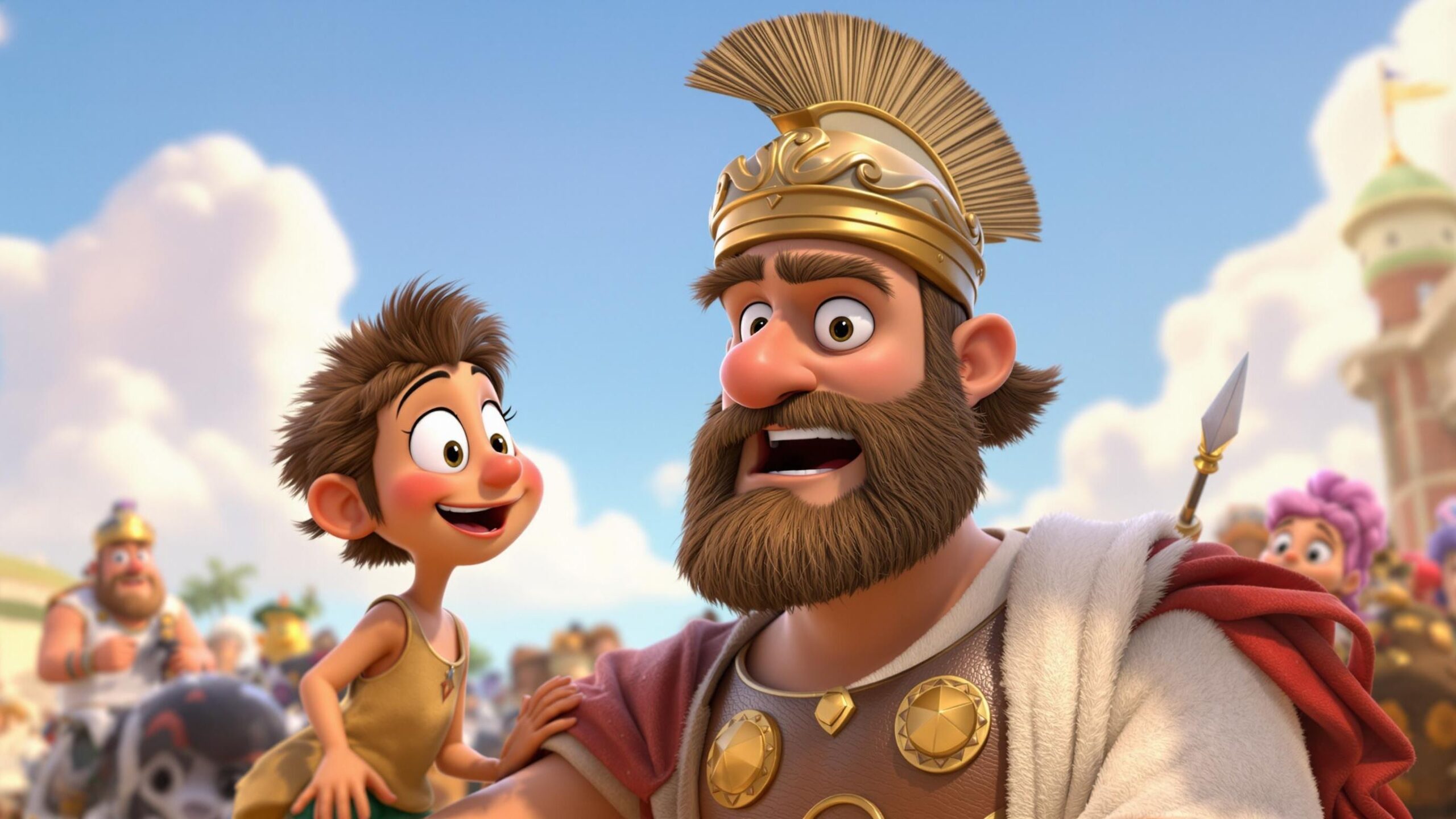In the dying days of the Roman Empire, when cracks splintered even the most formidable marble columns, a new kind of threat emerged—not from within, but from the vast grasslands beyond the Danube. His name was Attila, and he commanded not just an army, but a force of nature. Leading the Huns, a confederation of fearsome nomadic tribes, Attila didn’t build cities or monuments. He built terror. With speed, savagery, and shrewd diplomacy, he rode at the head of a whirlwind that tore through the boundaries of civilization. Where his horse’s hooves thundered, cities burned and emperors trembled. In an era of collapsing power and desperate alliances, Attila rose as a symbol of chaos—and an unstoppable conqueror who dared to threaten the very heart of Rome.
Born to Rule: The Rise of a Warlord
Attila was born around 406 CE into the royal family of the Huns, a nomadic people originating from Central Asia. Raised in a warrior culture that prized endurance, horsemanship, and cunning, he was trained from a young age to fight, ride, and rule. Alongside his brother Bleda, Attila inherited leadership of the Huns in 434 CE after the death of their uncle, King Rugila. The two brothers co-ruled the vast Hun confederation, which had already begun to exert pressure on the Eastern Roman Empire. They negotiated treaties and extracted tribute from Constantinople, leveraging fear into financial gain. But diplomacy wasn’t Attila’s final form—it was merely a tool in his war chest. By 445 CE, Attila stood alone as sole ruler, following Bleda’s mysterious death—likely at Attila’s own hands. With no rival left in his way, he began his brutal march across Europe, unifying disparate tribes under his leadership and turning the Hunnic Empire into a juggernaut of destruction.
The Scourge of the East: Rome’s Costly Peace
Attila’s first major target was the Eastern Roman Empire. Using swift cavalry raids and psychological warfare, the Huns devastated cities along the Danube and ravaged the Balkans. Constantinople, protected by mighty walls, held firm, but it didn’t come out unscathed. Emperor Theodosius II was forced into humiliating treaties that paid Attila enormous sums of gold just to keep the peace. But peace was never permanent with Attila. In 447 CE, he stormed through the Balkans again, razing cities, enslaving populations, and instilling panic throughout the empire. His methods were merciless—loot, burn, retreat, repeat. Yet, what made Attila truly dangerous was not just his brutality but his ability to wield fear as a weapon. Entire regions surrendered without a fight. Attila’s demands grew larger. He wanted gold, territory, and even a royal bride—he proposed to marry Honoria, sister of the Western Roman Emperor Valentinian III, who had secretly appealed to Attila for help in escaping a forced marriage. The request provided Attila with a perfect pretext to turn his attention west.
Invading Gaul: The Battle of the Catalaunian Plains
In 451 CE, Attila launched his most audacious campaign yet—an invasion of Roman Gaul (modern-day France). With an enormous army of Huns and allied tribes, he crossed the Rhine and left a trail of devastation. Cities like Metz and Reims fell in his wake. As panic spread across Western Europe, the Romans scrambled to respond. Aetius, the Roman general often hailed as “the last of the Romans,” formed a fragile alliance with the Visigoths, Franks, and other tribal forces. Together, they confronted Attila in one of antiquity’s bloodiest battles—the Battle of the Catalaunian Plains. Fought near modern-day Châlons, the battle was a brutal, chaotic clash. Though neither side achieved a clear, decisive victory, Attila was forced to retreat. It marked one of the very few times he was stopped. For Rome and its allies, it was a fleeting moment of hope. For Attila, it was just a delay.
The Italian Campaign: Rome’s Brush with Destruction
Undeterred by the stalemate in Gaul, Attila turned his fury toward Italy in 452 CE. He invaded the northern regions, sacked Aquileia—so thoroughly that the city disappeared from the map for centuries—and swept through the Po Valley. Cities were abandoned, refugees flooded the countryside, and the Western Roman Empire braced for collapse. But then, something extraordinary happened. As Attila approached Rome, an unlikely delegation arrived: Pope Leo I. The meeting between the Pope and the warlord remains shrouded in legend. Whether through spiritual persuasion, political reasoning, or practical logistics (Attila’s army was weakened by plague and famine), the result was astonishing—Attila turned back. Rome was spared, not by armies, but by a conversation. The event elevated Pope Leo’s status and added yet another layer to Attila’s enigmatic legacy. Was he a godless destroyer—or a man with enough foresight to know when to stop?
Death and Disintegration: The Empire Collapses
Attila’s death came swiftly and unexpectedly in 453 CE. After celebrating a new marriage to a young bride named Ildico, he was found dead the next morning. Accounts suggest he suffered a severe nosebleed or internal hemorrhage while drunk, choking in his sleep. Whether the cause was natural or assassination remains a mystery. His sudden death threw the Hunnic Empire into chaos. His sons, lacking his charisma and authority, fought among themselves. Rebellions erupted. Subject tribes defected. Within a year, the once-mighty empire splintered and crumbled. The storm had passed—but the scars it left on Europe endured.
The Legacy of Attila: Fear, Myth, and Memory
In his lifetime, Attila was both feared and admired. To his enemies, he was the “Scourge of God,” a punishment for Rome’s decadence and sin. To his own people, he was a hero, a unifier, and a warrior king. His image became a staple of medieval chronicles and later Romantic literature. He was painted alternately as a demonic barbarian or a misunderstood leader from a foreign world. In Hungary, where some trace their national ancestry to the Huns, Attila remains a name of honor. Cities, streets, and even children carry his name. In Western lore, however, he’s the quintessential barbarian—symbolic of the fall of empires and the fragility of civilization. Historians now see Attila not just as a destroyer but as a product of his time—a skilled diplomat and shrewd leader who knew how to extract wealth through war and negotiation. He never set out to rule Rome—only to break it, profit from it, and remind it that even empires can bleed.
The Scourge Who Redefined Power
Attila the Hun wasn’t a king in a crown or a statesman in robes. He was a warlord, shaped by the steppe winds and sharpened by conflict. He ruled not through lineage but through fear, brilliance, and might. For decades, he held two Roman Empires hostage with nothing more than his horsemen, his demands, and the terrifying promise of destruction. He didn’t just lead the Huns—he embodied them. Fast, fierce, and unpredictable. In a crumbling world of emperors and lost ideals, Attila stood as the last great outsider to shake the pillars of Rome and live to tell the tale—until, of course, death took him in the stillness of sleep. But even then, he refused to be forgotten.




